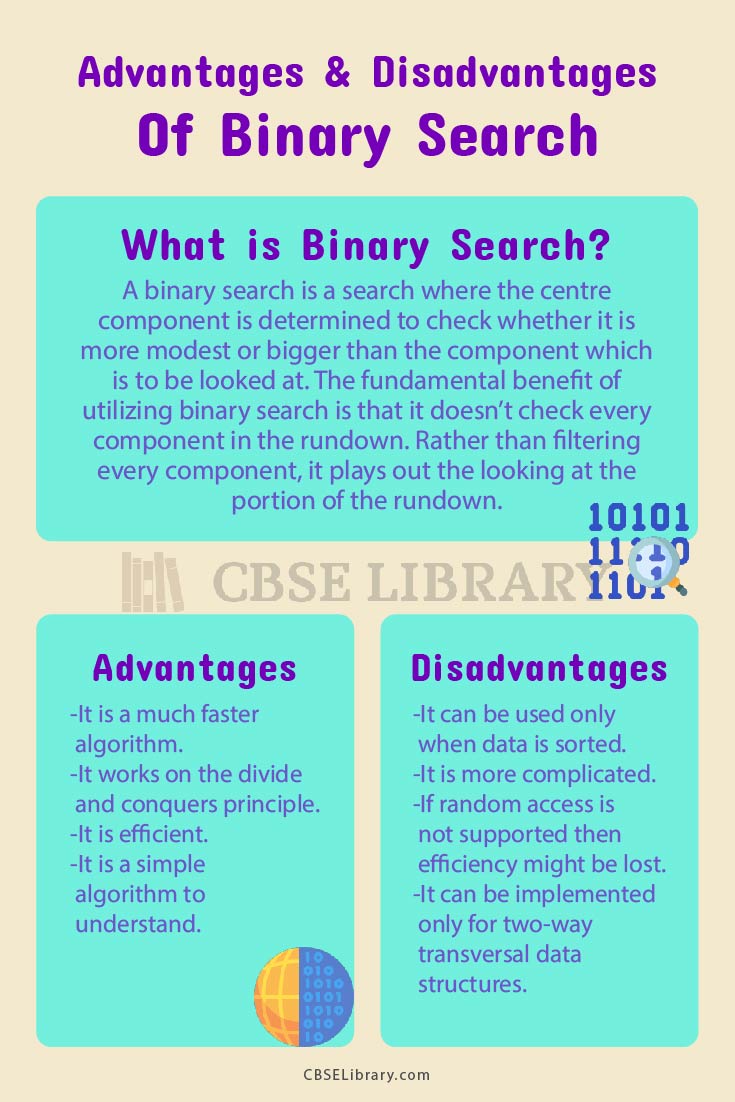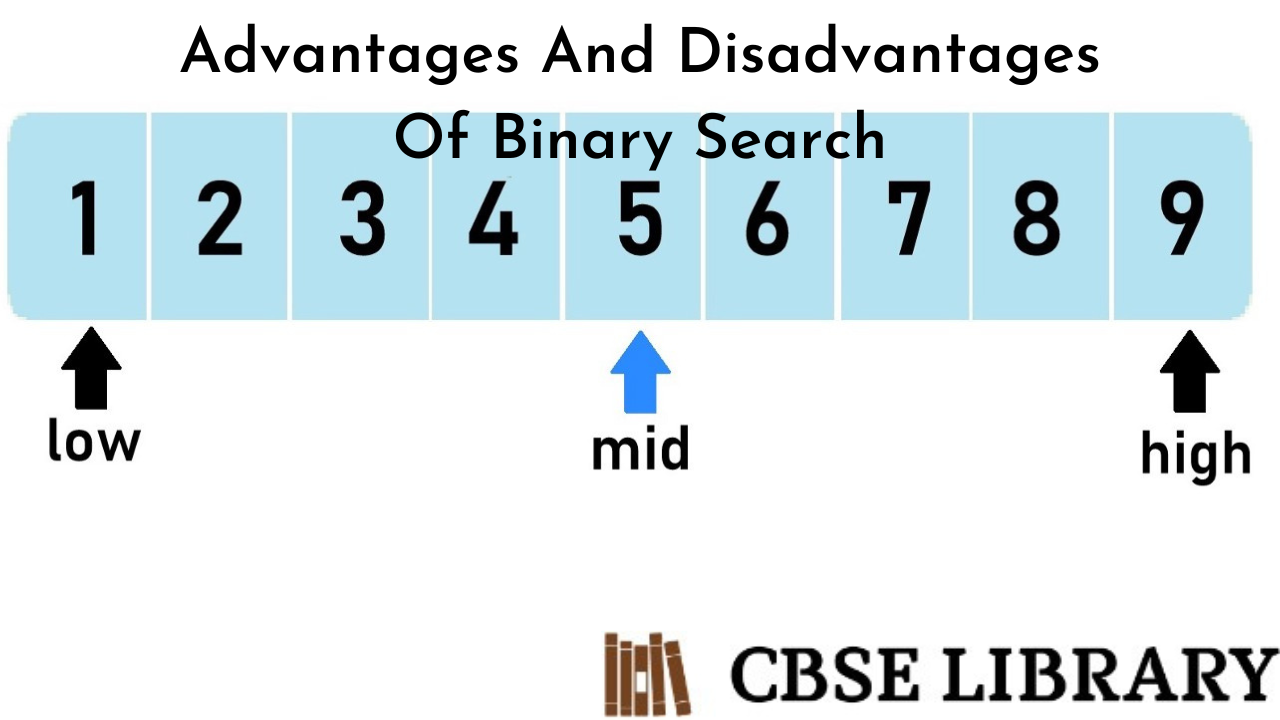Advantages And Disadvantages Of Binary Search: A binary search is a basic calculation for tracking down a thing in an arranged rundown of components or elements. It works by separating the list into halves and taking a gander at the main component in the top half (or the last component in the base half). In the event that the worth you are searching for is not exactly that component, dispose of the top portion of the rundown; in any case, dispose of the base portion of the rundown. Rehash with the excess half until you have just a single component left. In the event that the excess component is the one you were searching for, you’ve succeeded, generally, the worth you were searching for was not in the rundown. There are a couple of varieties, for example, testing for correspondence as well concerning not exactly at each progression, however, that typically copies the number of examinations.
One of the primary benefits of a binary search is that it is much faster than a sequential search in light of the fact that the information that should be looked through equal parts with each progression. For instance, it is feasible to look through 1024 qualities and find the one you need inside 10 stages, without fail. The most concerning issue with a binary search is that you can utilize this in the event that the information is arranged into a request.
Students can also find more Advantages and Disadvantages articles on events, persons, sports, technology, and many more.
What is Binary Search? Advantages and Disadvantages of Binary Search 2022
A binary search is a search where the centre component is determined to check whether it is more modest or bigger than the component which is to be looked at. The fundamental benefit of utilizing binary search is that it doesn’t check every component in the rundown. Rather than filtering every component, it plays out the looking at the portion of the rundown. In this way, the binary search gets some margin to look through a component when contrasted with a direct pursuit.
The one pre-essential of the binary search is that an exhibit ought to be in arranged request, though the direct pursuit chips away at both arranged and unsorted clusters. The binary search calculation depends on the gap and overcomes procedure, and that implies that it will separate the exhibit recursively.
It finds the place of the looked-through component by finding the centre component of the array. The pre-condition for the parallel pursuit is that the components should be organized in an arranged request. The execution of binary search is restricted as it tends to be carried out just on those information structures that have two-way crossing.
- Advantages of Binary Search
- Disadvantages of Binary Search
- Comparison Table for Advantages And Disadvantages Of Binary Search
- FAQs on Pros and Cons of Binary Search
Advantages of Binary Search
- Binary search is one of the quickest looking through calculations.
- It is utilized for tracking down the area of a component in a direct cluster.
- It chips away at the guideline of gap and overcomes strategy.
- It’s a genuinely straightforward calculation, whenever comprehended properly
- It’s notable and frequently executed for you as a library schedule
- It is preferred for large size data sets
- It is more efficient for large size data
- It is implemented on a multidimensional array
Disadvantages of Binary Search
- It’s more confounded than straight inquiry and is over the top excess for tiny quantities of components.
- It works just on records that are arranged and kept arranged. That isn’t generally feasible, particularly assuming components are continually being added to the rundown.
- It works just on component types for which there exists not as much relationship. A few kinds basically can’t be arranged
- There is an extraordinary loss of effectiveness on the off chance that the rundown doesn’t uphold irregular access. You want, for instance, to leap to the centre of the rundown right away. Assuming your rundown is a plain exhibit, that is perfect. On the off chance that it’s a connected rundown, not really. Contingent upon the expense of your correlation activity, the expense of navigating a non-irregular access rundown could predominate the expense of the examinations.
- There are significantly quicker search techniques accessible, like hash queries. Anyway, a hash query requires the components to be coordinated in a substantially more confounded information structure.
Comparison Table for Advantages And Disadvantages Of Binary Search
| Advantages | Disadvantages |
| It is a much faster algorithm | It can be used only when data is sorted |
| It works on the divide and conquers principle | It is more complicated |
| It is efficient | If random access is not supported then efficiency might be lost |
| It is a simple algorithm to understand | It can be implemented only for two-way transversal data structures |

FAQs on Pros and Cons of Binary Search
Question 1.
Can we use binary search for unsorted data?
Answer:
No, we can use a binary search algorithm only for sorted data or the data that are arranged in an order.
Question 2.
Binary search is suitable for large data sets. Is this statement true?
Answer:
Yes, binary search is suitable for large-size data sets, since it takes less time.
Question 3.
What are the advantages of binary search?
Answer:
The fundamental benefit of utilizing binary search is that it doesn’t examine every component in the rundown. Rather than checking every component, it plays out the looking at the portion of the rundown. In this way, the binary search gets some margin to look through a component when contrasted with a direct search.
Question 4.
What are the limitations of binary search?
Answer:
The significant impediment to binary search is that there is a requirement for the arranged cluster to play out the parallel inquiry activity. On the off chance that the cluster isn’t arranged the result is either not right or perhaps after a long number of steps and as per the information structure, the result ought to arrive in a base number of steps.
